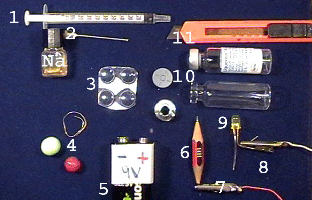Micrecol 1:
Microscale Chemical Experimentation investigating Red Sea water
M. K. El-Marsafy, P.Schwarz
 MicrEcol
is a neologism describing a new experimental access to chemistry even for
children:
MicrEcol
is a neologism describing a new experimental access to chemistry even for
children:
The materials as well as
the quantities of matter needed are unusually small (micro)
like drops from syringes or dropper bottles which are transferred to a
plastic surface or into a small infusion vial. Tiny quantities mean less
raw materials, less waste, less money, less space, less time, less energy
and more safety. So MicrEcol does not only have didactic and economic advantages
but also ecological ones.
"MicrEcol in Photos -Microscale
Science Experimentation with microlitre quantities-" also helps pupils
and students to learn and to teach chemistry using substances and
materials with volumes between 5 µL and 5 mL (Marsafy 1995, Marsafy
and Schwarz 1996, http://www.micrecol.de, Schwarz 2000).
Not only the quantities of
substances and the materials used for MicrEcol are small.
Even small children can
learn about their environment by doing experiments with the water they
are drinking and the air they are breathing (Lück, 1997).
Chemical education on the
primary level is part of integrated science ("Sachunterricht").
"The experiments
have to be designed so that they
• are as safe as possible
for the teacher, the pupils and students
• are time-saving (preparation,
performing, clearing away)
• are non-polluting to the
environment (reduction of waste)
• are cost-saving (material,
chemicals)
• can be referred to the
every day life (no chemistry of chemicals)
• can be used to illustrate
chemical theory." (Oberdrauf, 2000)
MicrEcol offers a chance for
sustainable learning of pupils even in areas without electricity and tap
water.
-
Empty DIN injection vials with
stoppers, blister packings, dropper bottles, (sterile!) syringes could
be found
even in small hospitals
in rural areas of Africa.
-
If necessary a two-pan scale
can be made from a used postcard (http://www.microchem.de/sssE7a.html).
Sodium pieces in the size
of rice corns can be obtaines and transported without danger.
-
Cost-free access to the know-how
needed to do and to evaluate the experiments is given by the Internet.
MicrEcol was developed in cooperation
with teachers in Austria, China, Egypt, Germany, Hungary, Israel, Jordan,
USA and Zimbabwe.
Life developed in sea water,
the bigger part of the Earth it covered by it, the first nine months of
human life takes place in a liquid which resembles sea water. Seawater
is the source of salt for kitchen and industry. More and more freshwater
is made by desalination of sea water.
So MicrEcol deals with sea
water first. Experiments with sugar cane and with lemon will follow.
Materials and Chemicals

1: 1-ml syringe,
2: blunt needle,
3:Blister packing
with four cavities,
4: Beads and wire
to model a NaCl crystal lattice,
5: 9-Volt battery,
6:
Pencil stub as anode,
7,8: Insulated wire
with crocodile clips,
9: Light emitting
diode (LED),
10: 5-ml DIN Injection
vial (Liquemin Roche) with stopper and 200-mg aluminium caps,
11:
knife
Na: Sodium (Na) pieces
smaller than a rice corn, KMnO4, HCl (conc. technical), Methylated
spirit.
Experiments:
 1.
Sea water made of different salt samples
1.
Sea water made of different salt samples
 ..................2.
Why kitchen salt made of sea water needs a separation additive
..................2.
Why kitchen salt made of sea water needs a separation additive
 ....
3.
Freezing of freshwater and sea water
....
3.
Freezing of freshwater and sea water
 .... 4. Crystal cubes
from sea water and from solutions of kitchen salt: Sodium chloride (NaCl)
.... 4. Crystal cubes
from sea water and from solutions of kitchen salt: Sodium chloride (NaCl)
 ........
5. Sea water a conductor for electricity while sodium chloride is transferred
into the gas chlorine (Cl)
........
5. Sea water a conductor for electricity while sodium chloride is transferred
into the gas chlorine (Cl)
 .........
6. Beads and cubes made of beads as models for salt particles and
for a salt crystal lattice
.........
6. Beads and cubes made of beads as models for salt particles and
for a salt crystal lattice
 .............
7.
The metal
sodium (Na) made of molten salt made of sea water
.............
7.
The metal
sodium (Na) made of molten salt made of sea water
 .8.
How sodium chloride (NaCl) is made from the metal sodium (Na) and the gas
chlorine
.8.
How sodium chloride (NaCl) is made from the metal sodium (Na) and the gas
chlorine
Literature:
Lück, G.: Jungforscher(innen)
im Kindergarten. Mit Feuereifer bei der Sache. In: CHEMIE HEUTE (Frankfurt
am Main) 1997/98, S. 108 - 111
El Marsafy, M.K. et al: The Microscale
chemistry laboratory technology its implications on the future Education.
In: Book of abstracts of the symposium on sciences and engineering education
in the 21st century (Cairo) 1995, S. 17 - 19
El Marsafy, M.K., Schwarz, P.:
Microscale Chemistry Experimentation. 119 pages english and arabic (Cairo)
1996
Obendrauf, V.: Low cost gas generation
for small scale hands on experiments. In: Book of abstracts of the 16.
International Conference on Chemical Education (Budapest) 2000, S. 8 -
15
Schwarz, P.: Chemische Unterrichtsexperimente
im Internet. In: CHEMKON/8 (1) 2001, S. 47
 MicrEcol
is a neologism describing a new experimental access to chemistry even for
children:
MicrEcol
is a neologism describing a new experimental access to chemistry even for
children:




